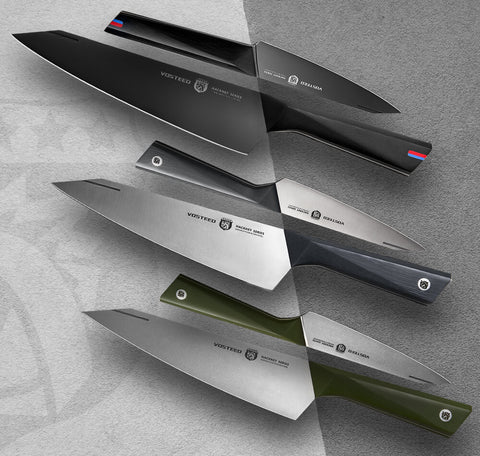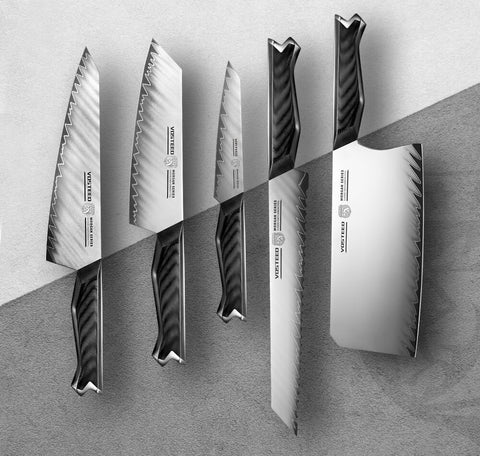Main features
The Kiritsuke knife is known for its hybrid style, meaning that it has two different traditional Japanese chef’s knives. It has a longer blade than an Usuba and a straighter edge than a Yanagi. In Japan, the Kiritsuke knife is for making sushi and sashimi. They are usually long(8-10″ long,) tall, and flat. The long and flat blade makes the Kiritsuke knife outstanding for slicing fish and vegetables, but it is not as perfect for using a rocking-chop technique as many Westerners prefer.
The Blade Grind
The blade grind comes with two variations of angles on a Kiritsuke. One is a single bevel, the other is double-beveled. Traditionally, these sword-like blades have been single-bevel and it is usually used by experienced chefs. However, the double-bevel Kiritsuke knife gradually Now the double bevel knife is common in the Western kitchen and it is easier for the user to handle and the knife will be more friendly to less professional users. The blade angle is formed on both sides, and the double bevel knives have a tall rectangular blade with a clipped point.
Updated designs from Vosteed
The Kiristuke knife in Vosteed has a wide blade which perfectly solves the problem of the Kiristuke knife. Featuring a wider blade, the Kiritsuke knife will be able to have more curves at the tip. Therefore, it allows you to rock the blade back and forth quickly and it is easier for people to control. This Kiritsuke knife is excellent for slicing and chopping. You will feel comfortable and enjoyable when you are cooking. Vosteed knives are sufficiently sharp, and their wider blade will be an advantage when you slice and cut things. There is no need to push it down while trying to cut things through. A wide blade will provide you with better stability and it is much safer, faster, and more precise when you are chopping and slicing.
Recommendations
1. Kiritsuke Chef's Knife 8.5" | Vosteed Hackney Series ©

This double-bevel Kirisuke knife features a Titanium Nitride coating that can harden and protect cutting surfaces and offers great rust resistance. Its high carbon steel blade is sharp out of the box, and it is perfect for multiple functions. The ergonomic handle will provide you a firm control even though you are using it with wet hands. If you are filleting a fish or making sushi, this Hackney series will slice the fish precisely with ease.
Pros:
1. 56-58 HRC: this hardness is usually applied to professional German kitchen knives. It is easy to sharpen and it remains sharp long enough for kitchen use.
2. Hackney series features with slope pinch which provides you greater control.
3. This titanium Nitride coating knife has more corrosion resistance than steel.
Cons:
1. A knife of this quality is not cheap. It might be over some budgets.
2. It might have more high-end features than a novice chef is looking for in a Kiritsuke blade.
2. Kiritsuke Chef's Knife 8" | Vosteed Morgan Series ©

This Kiritsuke Chef’s knife has a blade length of 8”. The wider blade of this knife has more curves at the tip, so this steel blade is flexible with multiple functions. This sleek Morgan Chef’s knife features with unique and gorgeous wave pattern which is naturally created instead of laser etched.
Pros:
1. 58-60 HRC: You can find the knife with this HRC in high-end quality kitchen knives such as Global and pocket knives such as Spyderco, and Buck
2. Sanmai structure allows softer steels surrounding the core, which makes for excellent corrosion resistance
3. It is a well-balanced and 1:1 handle-to-blade weight distribution ratio.
Cons:
1. Sleek and unique wave pattern might not fit everyone’s preference





Leave a comment
All comments are moderated before being published.
This site is protected by hCaptcha and the hCaptcha Privacy Policy and Terms of Service apply.